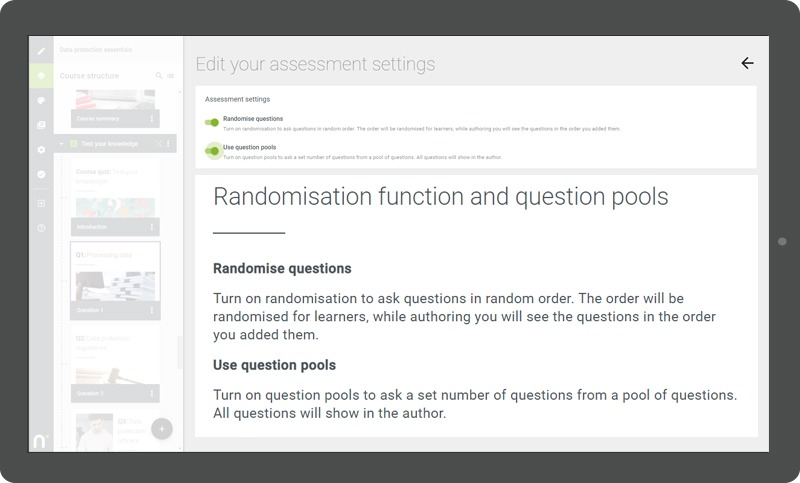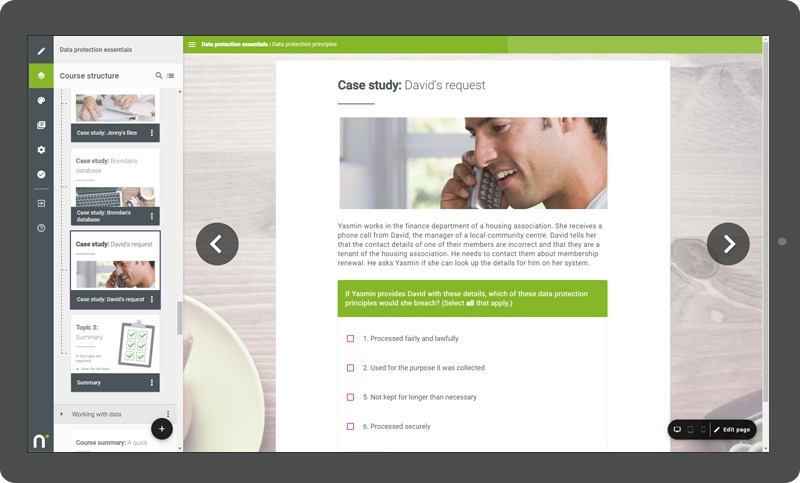When you’re writing an elearning course, you’ll probably want to add a short quiz at the end, just to check your learners’ knowledge. But did you know that the simple act of testing is possibly the most powerful learning tool we have? Careful use of questions that offer just the right level of challenge can actually improve retention of information in a dramatic way.
Think back to a time when you had to learn something, perhaps for an exam. What strategies did you use to get that information to stick? If you’re like most people, you probably went for one of the classic approaches we were taught to use in school: re-read and highlight key paragraphs, write up revision cards, or repeat short facts (like formulae and dates) over and over to memorise them. Well, it turns out that those classic cramming strategies are actually pretty inefficient. It might feel as though you’re getting to grips with the concepts you’re re-reading, but what’s actually happening isn’t really learning, just a cosy feeling of familiarity.
The testing effect
What works better than any of these memorisation attempts? Testing. In particular, testing yourself on material you don’t know very well, or that you’ve already begun to forget (Roediger & Karpicke, 2006). It’s not satisfying in the same way that copying out a passage from a textbook can be. In fact, people report finding this approach frustrating, and they remain convinced they’re not learning effectively. It doesn’t feel like you’re becoming fluent with the material – but evidence shows that attempting to recall information encodes it firmly in memory, despite feeling uncomfortable!
So, how can you apply this knowledge to improve the learning outcomes of your elearning courses? There are a few ways to work testing into your course design, but it’s always a good idea to be up-front with your learners about what you’re trying to achieve. Without this context, they are likely to get frustrated with what feels like constant quizzing before they’ve had a chance to learn the material fully. If you lay out the approach at the start of the course, including the scientific reason behind it, you’re far more likely to get buy-in from your learners.
Finish with an assessment
You can of course build a short quiz into the end of your elearning course. At Nimble, we highly recommend doing this with most courses: it gives people an opportunity to reach into their memory and recall what they’ve just learned, and is particularly effective if the questions place the knowledge into context (by asking learners to choose how they’d respond in a workplace scenario, for example). This has the added benefit of providing data about whether learners have read and retained the material – critical for demonstrating compliance. And even a quick assessment, administered shortly after learning has taken place, has a measurable impact on retention of knowledge.

Test again… and again
However, you may want to take this concept a step further. Research shows that regular testing of knowledge that’s just starting to slip out of our memories is extremely effective. Of course, in many workplace situations, this happens naturally; while we’re getting on with our jobs, situations arise regularly that require us to call up information and apply it. For critical information that employees need to know but isn’t used particularly frequently, you could consider creating a ‘top-up’ course that’s simply composed of assessment questions. Staff could then access this course every few weeks or months, and challenge themselves to remember and apply what they have learned.
There are a couple of things to keep in mind if you take this approach: first, make it clear that the whole point of this test is to learn, not to be judged. A low score isn’t a problem! You’ll also need to craft questions that are highly focused on the key information you need employees to know, and that provide a challenging real-life context. You could create a quiz like this quickly and easily using Nimble Author ’s question pools and randomise function; that way, learners can take the same assessment on multiple occasions but come across a different mix of questions each time.

Start with a quiz
Another approach might seem a little counterintuitive at first glance: try asking questions in your course before you’ve presented the material to be learned. There’s scientific evidence to suggest that simply asking people to think deeply about a concept before it’s taught – called pretesting – can improve learning (Richland, Kornell & Kao, 2009). We want our learners to feel comfortable accessing elearning – but not too comfortable! Learning that sticks often takes place when we’re working a little outside the limits of our understanding. Sometimes, making things difficult is exactly the right approach (Bjork & Bjork, 2009). You needn’t create an official assessment to do this; try using interactions that reflect the structure of quiz questions, but provide a low-stakes way for your learners to establish what they already know. With Nimble Author, you can build multiple choice questions or drag-and-drop interactions into any page of your course, and provide instant feedback (without judgement!) once the learner responds. These aren’t ‘graded’ like an assessment, but if you’re using the authoring tool alongside Nimble LMS, learner responses can be viewed in detail. This can give insight into employees’ understanding – and can help you to pinpoint which knowledge and skills may need further development.

Assessments and quizzes are rarely anyone’s favourite part of a course, but they are certainly a powerful tool that’s worth exploring. Letting learners know about the science behind the test can help bring them on board with a fresh approach. By revisiting the way you use questions in your elearning, you can really make your content stick – and know that the knowledge employees need will be there at their fingertips when it counts.


0 Comments